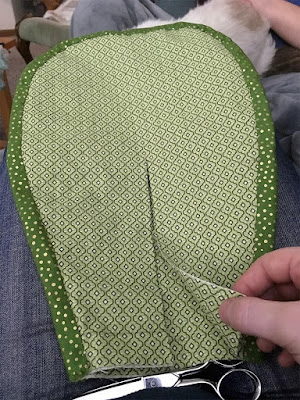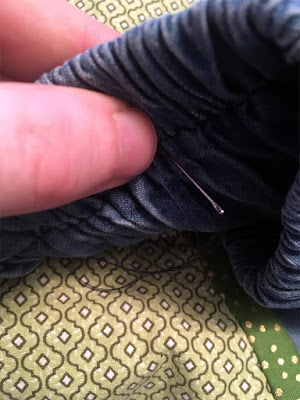The day that I am dead. That's the day I'll be done making pockets.
 |
| That's not ideal. |
I chose some leftover rust-orange linen for the last set of pockets I made
my beloved $6 denim skirt, and sadly, it has not lasted well at all. The amount of abrasion attendant on pockets (let alone my pockets, which are as likely to have a full set of cutlery or an entire sewing project in them as keys or a phone) meant that the linen softened up beautifully and quickly, and it proceeded to the 'whisper of a breath of linen' phase of existence equally quickly. The pictured pocket is the one in better shape—the other one has had a quarter-sized hole in it for mumblety-something weeks.
The orange pockets were made on roughly the same pattern as
the original green pockets, kind of a kidney bean with a flat edge to connect to the skirt slits. It's not a bad design, but they're prone to twisting around when they have things like keys in them, which leads to me yanking on them to get at my stuff, and that wears them out faster than necessary.
 |
| The roughest pattern ever. |
So I decided to try making 18th-century-inspired pockets, in more of a flat teardrop shape, with a slit running vertically down the middle. I measured the length of my skirt slits, since these would still have to match them, and eyeballed the rest of the pattern, which I cut on the fold originally for symmetry, and then traced entire on quadrupled fabric. Twice.
Yes, I have progressed to double-layered pockets, in hopes that when the fabric starts to wear, I'll have a chance to repair them before they're too far gone to patch.
 |
| Those seam allowances are outrageous. |
I started by flipping my pieces and retracing the seam lines. You may have noticed that I was cutting with the right side of the fabric facing me. That was wrong, I needed the wrong side visible, so that when I stitched the pocket panels and turned them, they'd be pretty side out. Oops.
I used a running back stitch on these, because why not, and then clipped only the really necessary bits of the curves and turned them.
 |
| I do regularly take over the break tables for sewing projects. |
I meant to press the panels before attaching them to each other, but time constraints demanded that I carry on with finger pressing only. It worked out fine. I also recently rediscovered the leftover trim from when I did up the inside hem of this skirt, and decided it would be cute to use it for pocket binding, too.
 |
| Oh good, it'll fit. |
The trim is pieced, and these pockets are already going to be so bulky at the edges (four layers of fabric per panel, plus four total layers of binding, is
twelve layers of fabric) that I didn't want to add seams into the mix, so I was delighted to discover that I had enough full-length panels of trim to do each pocket edge in one length, and use the scraps on the slit binding.
 |
| In retrospect, this was not a great plan. |
I tried stitching both edges of the binding on at once, sandwiching the panels between them. This probably would have made a fine pocket, and definitely would have sealed all the raw edges out of sight (and harm's way), but it also would have destroyed my fingers.
 |
| Yes, I have been changing locations often. |
So instead I used doubled thread to stitch the binding onto one panel, and then added the second into the stack, turned the free edge of the binding in, and felled it down (still with doubled thread, for strength).
 |
| I have to find a hobby that doesn't involve getting stabbed so much. |
That got a little...weird...but I made it all the way around the pocket eventually.
 |
| Pretty proud of how perfectly straight and on-grain I got these. |
With the binding on, I cut the slit down the center to make it a functional pocket.
 |
| Genuinely did not know what the plan was when I got to the turn there. |
And pinned a shorter scrap of trim on to start binding the slit—a simpler process, since I was working through fewer layers and less concerned about the strength of the stitching.
 |
| Ah. Improvisation. Brute force and all that. Good plan. |
When I got to the bottom of the slit, I just squidged the binding around until it sorta kinda fit, stitched it down firmly, and sped off down the other straight side. They're pockets, they don't have to be miracles of beautiful stitching, they just have to hold things.
 |
| Highly scientific measuring here. |
I folded the binding over until it looked good, which was basically whenever the raw edge touched the raw edges of the slit, and then rolled the folded edge over to lay flat and felled it down.
 |
| This was much easier than removing the first pockets. |
And then—because I'd been wearing it for significant parts of this process—I took the old pockets out of my skirt, one at a time, and attached the new ones so the top edges just hide behind the waistband.
 |
| Stabby stabby stab stitch. |
It was a lot of very careful stab stitching, and I may still go over it with another layer just to be certain. I'm hard on pockets.
I've also discovered, after a few days' experimentation with free pockets behind skirt slits, that as practical as that is from a seaming perspective, there's a serious risk of dropping my phone to the floor
inside my skirt, thanks to my modern understanding that pockets are attached to the fabric you reach through to put things in them. So I'll be tacking the pocket slits to the skirt slits someday soon, as well as binding the top edges (I had an errand, I was very excited about new pockets, these things happen). It's nearly a done thing, and that's good enough for me. Some sad day in the future, when this skirt finally falls apart beyond repair, I'll retrieve the pockets and maybe put them on their own waistbands to be worn individually.














Comments
Post a Comment